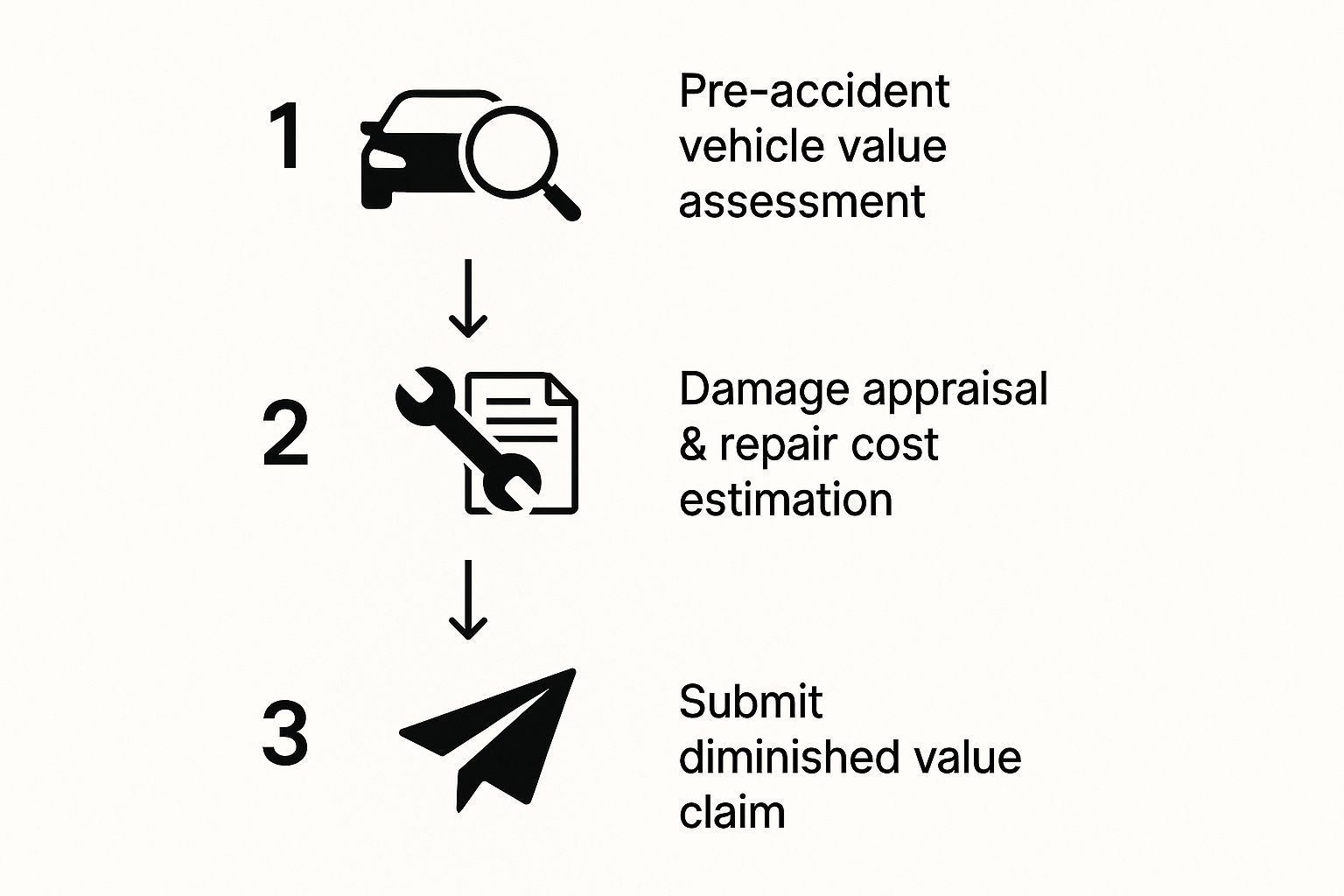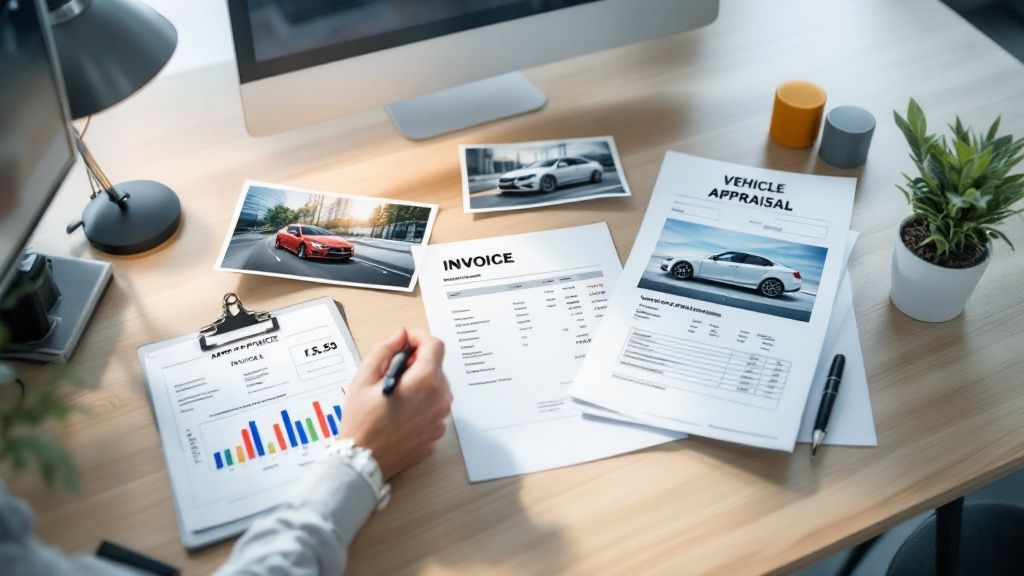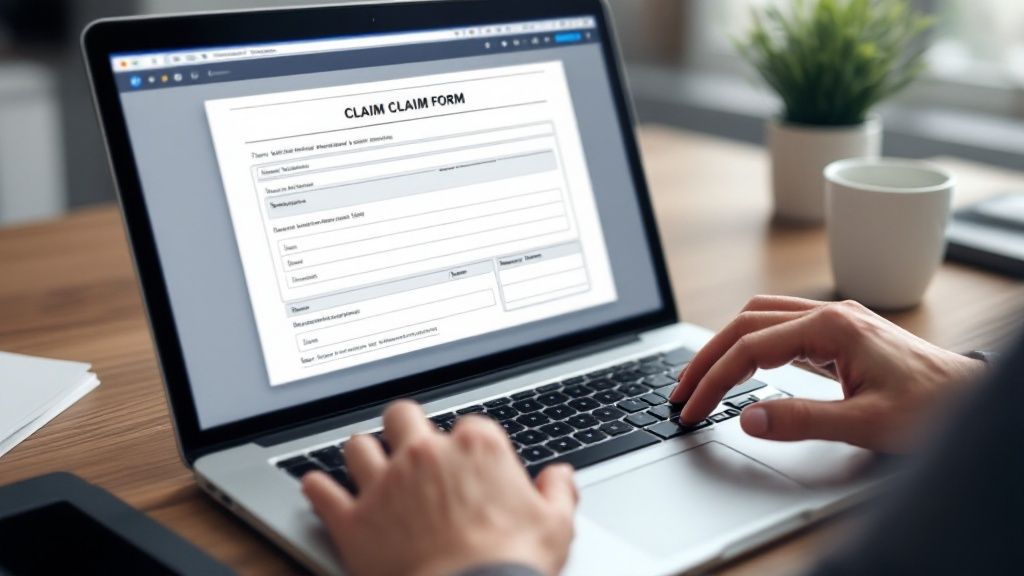Filing a diminished value claim is all about proving your vehicle lost a chunk of its market value after an accident, getting a professional to back that up with a solid appraisal, and then sending a formal demand to the at-fault driver's insurance company. At its heart, the process boils down to documenting that value loss and negotiating a fair settlement. It’s your way of getting compensated for the hit your car’s resale value takes, even after it looks brand new again.
What a Diminished Value Claim Means for You
Think of it this way: when another driver damages your car, the repairs can make it run and look perfect. But they can't erase the accident history. A vehicle with a recorded accident is simply worth less than an identical one with a clean record—that drop in market value is what we call "diminished value." Filing a claim is your right to recoup that loss from the insurance provider of the person who caused the crash.
This isn't about the money spent on repairs. It's about the permanent financial ding to your car's future selling price. Even with immaculate bodywork, a vehicle history report showing structural damage will make potential buyers hesitate or lowball their offers. This kind of value loss can slash a vehicle's worth by an extra 10-25% after a wreck, even when it’s been restored to its pre-accident condition. To get a better sense of the numbers, it helps to explore more about how depreciation impacts vehicle value and see what’s at stake.
Key Phases of the Claim Process
Getting this right requires a methodical approach. You need to start by establishing what your car was worth right before the accident and finish by formally negotiating with the insurer.
- Initial Assessment: First, you have to figure out your vehicle’s fair market value before the collision.
- Documentation Gathering: Next, pull together all the important paperwork—the police report, every single repair invoice, and photos of the damage.
- Independent Appraisal: This is critical. Hire a certified appraiser to write a professional, unbiased report that puts a hard number on the value your car has lost.
- Demand Submission: With all your proof in hand, you'll draft and send a formal demand letter to the insurance company.
- Negotiation: Finally, you or your representative will talk with the insurance adjuster to land on a fair settlement backed by your evidence.
This image lays out the basic flow for getting your claim started.

As you can see, assessing the value, documenting everything, and submitting the claim are the foundational steps you have to take in order.
Here’s a real-world example: Let's say Sarah's two-year-old SUV, worth $30,000, was rear-ended. The body shop bill came to $4,500. But after the repairs, a professional appraiser determined the vehicle lost an additional $2,800 in market value just because of the accident on its record. Armed with that detailed appraisal, Sarah filed a diminished value claim and successfully negotiated a $2,500 settlement to cover most of that loss.
Diminished Value Claim Process at a Glance
To make this even clearer, here's a simple breakdown of the entire process from start to finish.
| Stage | Key Action | Why It's Important |
|---|---|---|
| 1. Initial Assessment | Determine your vehicle's pre-accident market value using sources like KBB, Edmunds, and dealer quotes. | This sets the baseline for calculating how much value was lost. Without it, you can't prove a loss occurred. |
| 2. Evidence Collection | Gather the police report, photos of the damage, and all repair estimates and final invoices. | This is your proof. The more detailed your documentation, the stronger your case will be against the insurer. |
| 3. Professional Appraisal | Hire a certified, independent appraiser who specializes in diminished value. | An expert report from a neutral third party carries significant weight and is much harder for an insurer to dispute. |
| 4. Demand Letter | Draft and submit a formal demand letter to the at-fault party's insurance company with all your evidence attached. | This officially starts the claim and presents your case in a professional, organized manner, showing you're serious. |
| 5. Negotiation | Communicate with the insurance adjuster to discuss their offer and present your counter-arguments based on your appraisal. | Insurers almost always start with a lowball offer. This is where you fight for a fair settlement based on your evidence. |
| 6. Settlement | Agree on a final amount, sign release forms, and receive your compensation. | This is the final step where you are compensated for the proven loss in your vehicle's resale value. |
Following these stages in order gives you the best possible chance of a successful claim. It's all about building a logical, evidence-based case that an insurance company can't easily dismiss.
First Things First: Do You Even Qualify for a Diminished Value Claim?
Before you dive headfirst into paperwork and phone calls, let's figure out if filing a diminished value claim is actually worth your time. Not every fender-bender is going to result in a payout, and knowing where you stand from the get-go can save you a ton of frustration. Trying to push a claim that doesn't meet the basic criteria is usually a fast track to a denial letter from the insurer.
The absolute biggest hurdle to clear is this: you cannot be the at-fault driver. Think of diminished value as something you claim from the other person's insurance company—the one who caused the crash. Your own policy is there to fix your car, not to pay you for the hit its market value takes.
What Makes a Strong Claim?
Once you've established the other driver was at fault, a few other things really swing the odds in your favor. It all boils down to how much value your car had to lose in the first place.
A newer car with low miles and a clean history is the ideal candidate. It makes sense, right? A pristine, one-year-old car with 15,000 miles on the clock will see a much bigger drop in value after a major accident than a ten-year-old daily driver with 150,000 miles.
Keep these points in mind when sizing up your situation:
- Your Car's Age and Mileage: The sweet spot is usually for cars under seven years old with less than 100,000 miles. Older cars have already lost most of their value to normal depreciation, so it becomes much harder to argue that the accident caused a significant additional loss.
- How Bad Was the Damage? This is a big one. The more serious the damage, the stronger your argument. If your car had frame or structural damage, the impact on its resale value is pretty much a given and much easier to prove. A few paint scuffs or a tiny dent? That's a much tougher sell.
- The Quality of the Repair Work: Your claim is based on the simple fact that a car with an accident history is worth less, even if the repairs are flawless. This is called inherent diminished value. But, if the shop did a poor job—maybe the paint doesn't match perfectly or they used cheap aftermarket parts—that can actually give your claim even more ammunition.
Think of it like this: a 2022 sedan with 25,000 miles that needed frame repair is a textbook example of a strong claim. On the other hand, a 2014 hatchback with 120,000 miles that just got a new bumper is probably not worth pursuing.
Don't Forget to Check Your State's Rules
Where you live can make a difference. The vast majority of states allow you to file a diminished value claim against the at-fault driver's insurance. However, a handful have unique rules or restrictions.
It's a smart move to do a quick search on your state's specific laws before you get started. For instance, living in a "no-fault" state can sometimes add a layer of complexity, but it doesn't usually prevent you from filing a claim against the other driver’s property damage liability coverage.
So, if you weren't at fault, your car is fairly new, and the damage was more than just a scratch, you've got a solid foundation to build your claim.
Build A Strong Evidence Portfolio

At the heart of every solid diminished value claim lies a collection of facts your insurer can’t ignore. Insurance adjusters know how to spin opinions into minor payouts. When you line up hard evidence, though, you’re steering the conversation where it needs to go.
Think beyond presenting a handful of bills. Create a clear narrative—from photos at the crash scene to the final repair receipt—that charts the drop in your vehicle’s market value.
Start by gathering every piece of documentation tied to the accident and repair process. Each file is a brick in your case.
Gather Your Core Documents
Begin with the essentials that define what happened and what it cost:
- The Official Police Report: Fault determination is critical for third-party claims.
- Itemized Repair Invoices: Ask your body shop for a detailed breakdown of parts replaced, labor hours, and specific procedures.
- Proof of Pre-Accident Value: Print reports from Kelley Blue Book or NADAguides showing your car’s market value before the collision.
- Photos and Videos: High-resolution images from the accident scene and throughout the repair build a visual record.
Store these documents in a dedicated binder or digital folder. A logical, easy-to-navigate layout signals professionalism and readiness.
Key Takeaway: Adjusters are more inclined to approve a claim that’s comprehensive and neatly organized. Your goal is to leave no questions unanswered.
The Power Of An Independent Appraisal
Nothing carries more weight than an unbiased valuation from a certified appraiser. Insurers often default to internal formulas like Rule 17c, which tend to undercut your true loss. An independent expert, however, examines repair quality, surveys local sales, and delivers a market-based dollar figure.
To explore this further, check out our diminished value appraisal guide.
Modern vehicles come loaded with ADAS and complex electronics that rarely return to “like-new” status. An expert appraisal highlights these lingering imperfections and gives you a fortified position for negotiating a fair settlement.
Craft a Persuasive Demand Letter

With all your evidence gathered and organized, you’re ready to formally present your case to the insurance company. This is done with a demand letter—your official request for compensation that really sets the stage for the negotiation process.
Think of it this way: a sloppy, emotional, or poorly organized letter is easy for an adjuster to brush aside. But a professional, fact-based letter? That gets their attention. It shows them you're serious about recovering every dollar you're rightfully owed.
The goal here is to be firm, clear, and respectful. You aren't just asking for a check; you're laying out a logical, evidence-backed argument for your vehicle's lost value. This is your opening statement, and it needs to be compelling right from the start.
Key Components of an Effective Letter
A powerful demand letter isn't about length; it's about structure. Each piece of information should logically build on the last, guiding the adjuster to the clear conclusion that your claim is valid and your figure is fair. You want to walk them through the facts without any angry rants or unnecessary fluff.
Make sure your letter hits these essential points:
- The Basics Upfront: Start with your name, the date of the accident, your claim number, and the at-fault driver's name.
- A Quick Recap: Briefly describe the accident, making sure to state that their insured driver was at fault (as confirmed by the police report you're including).
- Your Stated Purpose: Clearly state that you are filing a third-party diminished value claim to compensate for the loss in your vehicle's fair market value.
- The Bottom Line: Present the specific dollar amount you've calculated for your diminished value, pointing directly to your independent appraisal as the source of that figure.
Expert Tip: I can't stress this enough—send your demand letter and all its attachments via certified mail with a return receipt requested. This gives you legal proof that the insurance company received everything, so they can't come back later and say it got lost in the mail.
Presenting Your Evidence
This is the part where you connect your demand to the proof you’ve worked so hard to gather. Don't just say you have an appraisal; highlight its main conclusion.
For instance, you could write something like, "As detailed in the enclosed report from Certified Auto Appraisers, my 2022 Honda CR-V has suffered $4,250 in inherent diminished value as a direct result of the structural repairs required after the collision."
It's also a good idea to include a simple bulleted list of all the documents you've enclosed. This makes the adjuster's job easier and shows you're organized. If you want to see some examples and get more in-depth advice, you can learn more about crafting a powerful insurance demand letter to make sure you've covered all the angles.
Finally, always address the letter to the specific claims adjuster by name. It’s a small detail that shows you’ve done your homework. A well-written letter, backed by a solid portfolio of evidence, is your single best tool for kicking off a successful negotiation.
Negotiating With the Insurance Adjuster Like a Pro

Alright, you've sent your demand letter. Now comes the part that can feel like a high-stakes chess match: the negotiation. The adjuster will review your documentation and come back with an offer. I'll be blunt—expect that first offer to be low. Very low.
This isn't personal; it's just business. It's a standard opening move designed to see if you'll just take the money and go away. Your job is to stay calm, stick to your evidence, and remember your goal: getting paid what you're actually owed for your car's lost value.
Countering the Dreaded "17c Formula"
More often than not, the adjuster’s lowball offer will come from a notorious calculation called the "17c formula." Insurance companies love this thing because it almost always spits out a tiny number. It uses arbitrary caps and modifiers that have little to do with your specific car, the damage it sustained, or the realities of your local used car market.
When the adjuster brings it up, don't panic. You now have the upper hand because you can call it out for what it is—a flawed, generic calculation.
Here's how you can push back politely but firmly:
- "The 17c formula is a one-size-fits-all approach that doesn't account for the actual market conditions here."
- "My independent appraisal is based on real-world sales data for comparable vehicles, which is a far more accurate way to determine the loss."
- "Can you walk me through the specific variables you used? I'd like to see how they stack up against my appraiser's market analysis."
By doing this, you're not getting into an argument. You're simply shifting the focus from their internal, insurer-friendly formula to your hard, market-based evidence. You’re comparing apples and oranges, and you need to show them why their orange is just a flimsy estimate.
A Quick Real-World Example: I worked with a client in Portland who was offered $500 for diminished value on his two-year-old Accord after a nasty rear-end collision. The adjuster cited the 17c formula. We calmly presented our $2,800 independent appraisal, walked the adjuster through the local comps we used, and pointed out the formula's shortcomings. The final settlement? $2,200. Not bad for a couple of well-prepared phone calls.
Keeping the Conversation on Your Terms
From this point on, every conversation is part of the record. You need to be meticulous. If you're looking for more in-depth strategies, our guide on how to deal with insurance adjusters is a great resource.
Treat this like a project and keep a running log of everything:
- Calls: Date, time, the adjuster's name, and a quick summary of what was said.
- Emails: Keep every single one in a dedicated folder.
- Follow-ups: Don't be afraid to politely set deadlines. A simple "I'll look for your updated offer by Friday" keeps things moving.
The industry is seeing a sharp increase in total loss claims—they now make up 22.6% of all collision claims. And with the average car on the road being 12.8 years old, insurers are constantly dealing with older, more complex vehicle valuations. This data, highlighted in the CCC Intelligent Solutions 2025 Crash Course report, actually works in your favor. A well-documented DV claim on a newer vehicle stands out, and adjusters know they can't just dismiss it.
If the adjuster digs in their heels and won't budge from an unfair number, you still have moves to make. You can file a formal complaint with your state's Department of Insurance or, depending on the amount, take the matter to small claims court. Sometimes, just demonstrating that you know your rights and are prepared to escalate the issue is all it takes to get a fair offer on the table.
Your Diminished Value Questions, Answered
Even when you know the steps, filing a diminished value claim can feel like navigating a maze. It's completely normal for questions to pop up along the way. Getting solid answers is the best way to keep moving forward and avoid the common traps that can derail a claim.
Let’s walk through some of the most common questions people have when they're in the thick of it.
Can I File a Diminished Value Claim If I Was at Fault?
This is a big one, and the answer is almost always no. Think of a diminished value claim as something you file against the other driver’s insurance—specifically, their property damage liability coverage.
Your own collision policy is there to cover the cost of repairs to your car, but it doesn't cover the drop in its market value after the fact. Fault is the deciding factor here. To be eligible, you have to be the victim in the accident.
There are a few incredibly rare exceptions. In a state like Georgia, for instance, you might be able to file against your own policy if the at-fault driver was uninsured. But for nearly everyone else, you can only pursue a claim if the other party was responsible.
How Is the Amount of Diminished Value Calculated?
Insurance companies have their methods, but the one that truly holds up is an appraisal from an independent, certified expert. This is how you get an unbiased valuation backed by solid evidence—the kind an adjuster can't easily dismiss.
A professional appraiser looks at the whole picture:
- The make, model, age, and mileage of your vehicle.
- What it was worth before the accident, including its condition and any previous damage history.
- How bad the damage was and, just as importantly, the quality of the repair work.
- Real sales data from your local market for similar cars that have a clean history.
Insurers love to use their own internal calculation, often called the 17c formula. It's notorious for spitting out lowball numbers. Getting your own professional appraisal is the single most powerful tool you have to counter their formula and fight for what your car has actually lost in value.
Relying on the insurer's formula is like letting the opposing team's coach be the referee. An independent appraisal ensures a fair game by bringing in a neutral, expert opinion based on verifiable market facts, not internal algorithms.
What If the Insurance Company Refuses to Pay?
Don't panic if the adjuster denies your claim or comes back with a ridiculously low offer. This is often just part of their process. Your first step is to respond with a formal, written counteroffer.
In your letter, calmly lay out the facts. Reference the key findings from your professional appraisal and connect them directly to the amount you're requesting. Make it clear that your number is based on evidence, not emotion.
If they still won't budge, you have more options. You can file a complaint with your state’s Department of Insurance, which can sometimes get the insurer to take your claim more seriously. And if the amount is within the limit for small claims court, that's another practical route to getting a fair judgment.
When Should I Submit My Diminished Value Claim?
Timing is everything. Every state has a legal deadline for filing property damage claims, known as the statute of limitations. This can be anywhere from six months to several years, so it's critical to look up the specific law for your state.
The best time to file is right after your vehicle’s repairs are finished. Once you have that final, itemized repair invoice in your hands, you’re ready to go. This timing gives you a complete picture of the damages and plenty of runway to get your appraisal done and negotiate without the pressure of a looming deadline.
At Total Loss Northwest, we specialize in providing certified, independent appraisals that give you the leverage you need. If you're facing a diminished value claim or a total loss settlement dispute in Oregon, Washington, or anywhere in the U.S., let us help you fight for the true value of your vehicle. Visit Total Loss Northwest to get the expert support you deserve.





